Abstract
Beech wood is a material commonly used for furniture, and cutting performance is the key to improving product quality and enterprise benefits. In this work, beech milling experiments using diamond cutters were carried out, and the changes in cutting power, temperature, and surface roughness were examined using the factor analysis method. The main results of this work are listed as follows: Firstly, a higher cutting speed and depth led to higher cutting power, temperature, and surface roughness. Meanwhile, cutting power and surface roughness were negatively related to the rake angle; however, cutting temperature first increased and then decreased with the increase in rake angle. Furthermore, cutting depth had greatest impact on the cutting power and surface roughness, followed by rake angle and cutting speed. Cutting speed had the greatest contribution to the cutting temperature, followed by cutting depth and rake angle. Only the cutting depth had a significant contribution to both cutting power, temperature, and surface roughness. Finally, optimal cutting parameters were determined to be a rake angle of 15°, cutting speed of 54 m/s, and depth of 0.5 mm. These values best meet the multiple objectives of lower cutting power, temperature, and surface roughness, which relate to superior product quality and enterprise benefits.
1. Introduction
With the rapid development of the furniture industry, various solid woods and wood-based composite materials are being widely used in furniture manufacturing [1,2,3,4]. Beech wood (Fagus sylvatica L.) is one of the ideal materials for furniture with respect to its excellent mechanical properties and beautiful appearance and texture [5]. To process components of differing sizes and shapes, beech wood requires multiple cutting processes, such as turning, milling, and planing [6,7,8]. Therefore, the cutting performance of beech wood has always been a research hotspot in the field of material processing.
Related work on beech cutting performance indicates that cutting force, power, temperature, and quality are crucial indicators for evaluating the machinability of beech, and these factors are mainly affected by the tool angle and cutting parameters [9,10,11]. Changes in sawing force and specific sawing resistance in modified beech were researched by Hlásková et al. [12], and a circular sawing model was developed to describe the yield strength and toughness of fracture. Meanwhile, the specific energy during machining of beech was investigated by Kratky and Jirout [13], and a model was developed to determine the effect of the knife mill variables and hip characteristics on the changes in specific energy requirements. Ispas et al. [14] explored the influences of spindle speed and cutting depth on cutting power and surface roughness when milling untreated and heat-treated beech. This work indicated that higher spindle speed, feed speed, and cutting depth have a positive effect on cutting power, and that surface roughness increases with the increase in feeding speed. Furthermore, surface roughness was explored by Kubš and Kminiak [15] in the milling of thermally modified solid beech. They found that a lower feed speed and a higher cutting speed improved the machined surface. Furthermore, based on an adaptive neuro-fuzzy inference system and response surface method, predicted models were developed by Zhu et al. [16] to find the relationship between the surface roughness of beech and cutting parameters. Optimal cutting parameters were determined to improve the finishing quality of beech.
Beech is a hardwood that is prone to cracks during the cutting process due to its high hardness [17]. Therefore, the actual production process has some shortcomings, such as low material utilization, high energy-consumption, and poor product quality [18,19,20]. Based on the related reports [21,22,23], different cutting parameters directly affect wood cutting energy consumption and surface quality. Reasonable cutting parameters can improve product cutting quality and efficiency and reduce processing costs. Therefore, determining scientific cutting parameters to improve enterprise efficiency and product quality is an urgent problem to be solved for the beech processing industries [24].
With the objective of appraising the cutting performance of beech wood, this work systematically identifies the changes in cutting power, cutting temperature, and surface roughness of beech wood at different cutting parameters. Meanwhile, the optimal cutting parameters are determined with a view of providing scientific theoretical guidance for beech machining.
2. Materials and Methods
2.1. Workpiece and Cutting Tool
In this work, beech was used as the testing material, and its material properties are listed in Table 1. Workpieces had dimensions of 500 mm length, 160 mm width, and 4 mm thickness. Three diamond-cutting tools with cylindrical profiles and radii of 70 mm were adopted. These tools have cutting blades with working lengths of 6 mm oriented parallel to the axis of rotation and arranged in six rows. The tool is fixed in the holder with an elastic collet. The angle parameters and properties of cutters are given in Table 2 and Figure 1a (Leuco Precision Tooling Co., Ltd., Suzhou, China).

Table 1.
Material properties of beech.

Table 2.
Angle parameters and material properties of cutting tools.
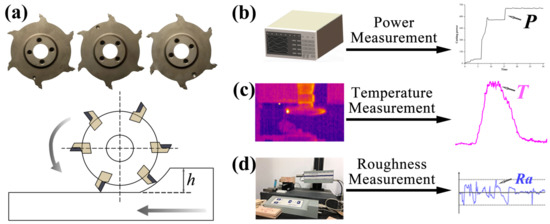
Figure 1.
(a) Cutting tools and up-milling, (b) cutting power measurement, (c) temperature measurement, and (d) surface roughness measurement.
2.2. Experimental Set-Up
As shown in Figure 1a, up-milling was performed on an MGK01 CNC machining centre (Nanxing Equipment Co., Ltd., Dongguan, China), and feed direction was parallel to the wood fibre. The dynamic cutting power, including unloading and cutting states, was acquired using an AN87300 three-phase power analyser (Ainuo Co., Ltd., Jinan, China) on the power cord of the machine, with sampling frequency of 50 KHz. The cutting power was obtained from the difference between power during unloading and cutting states. The dynamic temperature of the cutting zone was measured using an A20-M infrared imaging camera (Figure 1b, Thermo Fisher Scientific Inc., Waltham, MA, USA) with 50 Hz sampling frequency at room temperature of 14.5 °C. The maximum temperature in the cutting zone was calculated using the software of ThermaCAM Researcher Pro (Version 2.10). The roughness value of the machined surface was obtained using a probe-type surface roughness–measuring instrument (JB-4C, Shanghai Taiming Optics Co., Ltd., Shanghai, China), and the measurement direction was parallel to both the feeding direction and the wood fibre.
In this work, the cutting width remained constant at 4 mm, and the cutting variables were selected as follows: rake angle of cutter in degrees (°), cutting depth in mm (the thickness removed from workpiece, Figure 1a), and cutting speed in m/s. The level of each cutting variable was determined based on current practices in beech machining and related reports. The experiments focused on the following dependent variables: cutting power (P) in W, temperature (T) in °C, and surface roughness (Ra) in μm. Details of the experimental design are tabulated in Table 3. Each combination of cutting parameters was repeated five times, and average values of cutting power, temperature, and surface roughness were used for further analysis.

Table 3.
Experimental design and resulting cutting power (P), temperature (T), and surface roughness (Ra).
2.3. Analytical Method
The factor analysis method was applied in this work using Minitab statistical software (Version 18, Minitab Inc., PA, USA). Factor analysis is a statistical method for extracting common factors from a population of variables. The method classifies variables with similar properties into a factor, which can reduce the number of variables and verify the correlation between variables. Factor analysis involves the synthesis of various factors, and its algorithm is based on correlations between original data. It uses mathematical statistics to summarize many interrelated problems into several new independent variables. In other words, original variables are expressed in new forms that can effectively clarify the relationships between variables and dependent variables [25].
3. Results and Discussion
3.1. Effect of Cutting Parameters on Power
In material milling, milling power is a major indicator of the energy consumption of the machine tool [26]. According to the testing results analysed via Minitab and displayed in Table 3, Figure 2a shows the relationship between cutting power (P) and tool rake angle. It can be concluded that cutting power decreases as the rake angle of the cutter increases. As the rake angle increases, the resistance encountered by the cutting edge when cutting into and out of the workpiece is reduced, thereby reducing the power of the machine tool. Therefore, cutting power shows a negative correlation with rake angle. As shown in Figure 2b, the cutting power increases with the increase in cutting depth. The increase in cutting depth leads to a greater quantity of material removed by the cutter per unit time. This produces a higher resistance at the cutting edge and, therefore, increases cutting power. Thus, cutting power and cutting depth are positively correlated. Figure 2c reveals the relationship between cutting power and cutting speed, in which cutting power increases with the increase in cutting speed. As the cutting speed increases, the machine tool needs to consume more energy to turn the spindle faster, inevitably increasing the input power of the machine tool. Therefore, an increase in cutting speed raises the cutting power.

Figure 2.
Effects of (a) rake angle, (b) cutting depth, and (c) speed on the cutting power.
Figure 3 shows the results of Pareto analysis of the cutting power, with a significance level of 5 percent (α = 0.05). This chart can display the significance of each cutting variable affecting the experimental result. When the value of a cutting variable exceeds the red reference line, it can be considered a significant variable; otherwise, it is insignificant. Therefore, the variables of cutting depth (h) and rake angle (α) both have significant contributions to cutting power, while the cutting speed (vc) has an insignificant influence on cutting power. This result is consistent with the cutting power during the milling process of wood–plastic composite [27]. According to a related work, different cutting parameters have interactive effects on the cutting power [8]. Based on interaction analysis of cutting power, as shown in Figure 3, only the interaction of cutting speed and depth (vc × h) has a significant contribution to the cutting power, while the interactions of rake angle and cutting depth (α × h) and rake angle and cutting speed (α × vc) have insignificant effects on the power. Table 4 displays the factor analysis results of cutting power. The delta value of a cutting variable indicates the degree of influence on the cutting power. A higher delta value of a cutting variable indicates that this cutting variable has a greater contribution to cutting power. In these experiments, the delta value of cutting depth (h) is equal to 93.04, which is higher than those of rake angle (α, 41.04) and cutting speed (vc, 5.15). Therefore, cutting depth has the greatest impact on the cutting power, followed by rake angle and cutting speed.
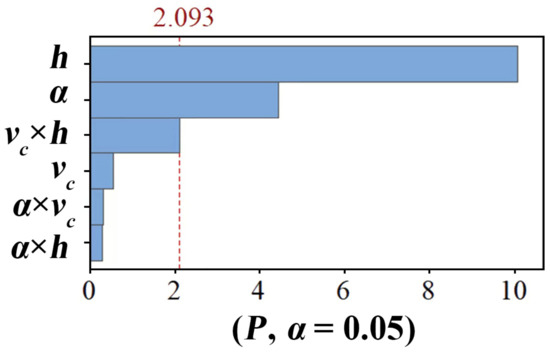
Figure 3.
Standardization of the effects on cutting power.

Table 4.
Factor analysis results of cutting power.
3.2. Effect of Cutting Parameters on Temperature
Cutting temperature is generated from the plastic deformation of the cutting zone and the friction between tool and workpiece. Figure 4a shows the cutting temperature at different rake angles analysed via Minitab. As rake angle increases, cutting temperature first decreases, and then increases. With the first increase in rake angle, a reduction in cutting resistance inhibits the generation of cutting heat. However, as the rake angle of the cutter increases further, greater friction is generated between the chip and rake surfaces, which intensifies heat generation, resulting in an increase in cutting temperature. Meanwhile, as shown in Figure 4b, the cutting temperature shows an increasing trend with increased cutting depth. This phenomenon is consistent with the cutting temperature in the sawing of hem-fir wood [28]. The increasing cutting depth removes a greater quantity of material, which is needed for higher throughput cutting work. This kind of cutting work produces a greater amount of cutting heat, thereby leading to a higher cutting temperature. Finally, Figure 4c shows the relationship between temperature and cutting speed. Note that the cutting temperature increases as the cutting speed increases. The higher cutting speed results in a greater frequency of friction events at both the rake face–chip interface and the flake face–machined surface interface. This leads to a higher cutting temperature. Thus, the cutting temperature is positively correlated with the cutting speed.

Figure 4.
Effects of (a) rake angle, (b) cutting depth, and (c) speed on the cutting temperature.
The Pareto results of cutting temperature with a significance level of 5 percent (α = 0.05) are given in Figure 5, illustrating the significance of different cutting variables affecting the temperature. The variables of cutting depth (h) and speed (vc) have a significant influence on the cutting temperature, while the rake angle (α) has an insignificant contribution to the cutting temperature. Diamond has excellent thermal conductivity and can quickly dissipate the heat generated in the cutting area. Thus, the rake angle of the cutter only insignificantly affects the changes in temperature. In similar research, Song et al. [29] showed that changes in cutting temperature of bamboo–plastic composite were affected by the interactions of cutting parameters, such as cutting depth, tool number, and speed. However, from Figure 5, it is clear that, in this work, all three interactions of rake angle and cutting speed (α × vc), cutting speed and depth (vc × h), and rake angle and cutting depth (α × h) insignificantly affected the cutting temperature. Finally, based on the delta values of the cutting variables listed in Table 5, the delta value of cutting speed (vc, 5.04) is higher than those of cutting depth (h, 4.07) and rake angle (α, 1.49). Hence, the cutting speed has the greatest contribution to the cutting temperature, followed by cutting depth and rake angle.
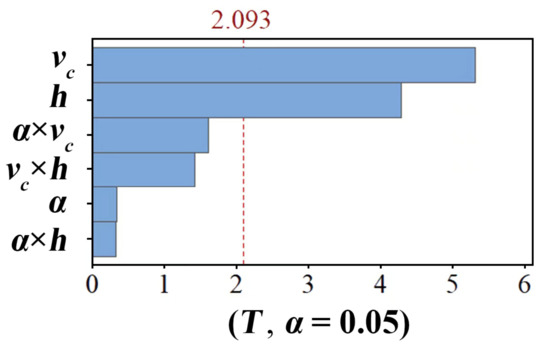
Figure 5.
Standardization of the effects on cutting temperature.

Table 5.
Factor analysis results of cutting temperature.
3.3. Effect of Cutting Parameters on Surface Roughness
Surface roughness is a crucial evaluation index for the final surface of a workpiece. Figure 6a shows the relationship between surface roughness and rake angle. It can be seen that surface roughness shows a decreasing trend with the increase in rake angle. As the rake angle of the tool increases, it is easier for the cutting edge to cut into and out of the workpiece. This improves the cutting stability as the chip is removed from the workpiece. Therefore, the surface roughness is negatively correlated with the rake angle. The effects of cutting depth and speed on the surface roughness are given in Figure 6b,c, respectively. Surface roughness gradually increases with increasing cutting depth and decreasing speed. According to related reports, cutting stability is the key factor affecting machined surface roughness. Cutting stability is determined by tool geometry, workpiece characteristics, and cutting quantity, among other factors. The increase in cutting depth and decrease in speed mean that there is a greater feed per tooth and greater cutting thickness. This results in a higher resistance acting on the tool edge when removing the chip, which decreases the cutting stability. Therefore, changes in surface roughness have a positive correlation with cutting depth and a negative correlation with cutting speed.

Figure 6.
Effects of (a) rake angle, (b) cutting depth, and (c) speed on the surface roughness.
Figure 7 displays the Pareto results for surface roughness with a significance level of 5 percent (α = 0.05). It shows how significantly the different cutting variables affected the surface roughness. Only the cutting speed exceeds the reference line, indicating that only the cutting depth (h) makes a significant contribution to the surface roughness. Surface roughness is insignificantly affected by both the rake angle (α) and the cutting speed (vc). Surface roughness is an important parameter that represents the quality of a machined surface. It is influenced by factors such as workpiece material, cutting parameters, and tool geometry [30,31,32]. However, as given in Figure 7, none of the values for the interactions of rake angle and cutting speed (α × vc), cutting speed and depth (vc × h), and rake angle and cutting depth (α × h) exceed the red reference line. Therefore, these interactions have insignificant impacts on surface roughness. Furthermore, according to the delta values of the cutting variables listed in Table 6, the delta value of cutting depth is equal to 1.56. This is larger than those of rake angle (0.69) and cutting speed (0.52). Therefore, it can be concluded that the cutting depth has the greatest contribution to surface roughness, followed by rake angle and cutting speed.
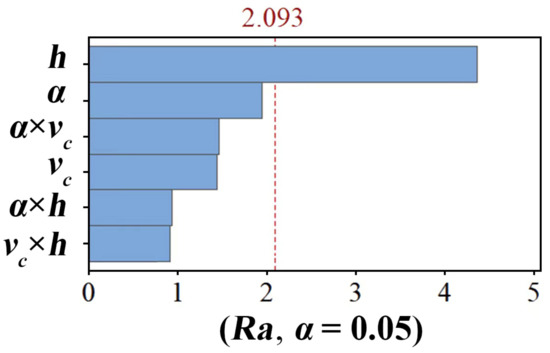
Figure 7.
Standardization of the effects on surface roughness.

Table 6.
Factor analysis results of surface roughness.
3.4. Optimisation of Beech Cutting Parameters
In the industrial machining of beech, optimal power consumption, tool wear, and final quality are three key indexes relevant to enterprise benefits and product quality [33,34,35,36]. Thus, to improve cutting quality and reduce the energy consumption of the machine tool, a multi-objective optimisation was carried out. Surface roughness directly affects the surface quality of the final product, and this was taken as the first optimisation priority. Cutting power was selected as the second optimisation priority, as it only impacts the machine tool’s energy consumption. In this application, the overall cutting temperature is low and, thus, has limited impact on tool wear. Therefore, cutting temperature was selected as the third optimisation priority. As given in Figure 8, the ranges of cutting variables were set as follows: 5° < rake angle (α) < 15°; 18 m/s < cutting speed (vc) < 54 m/s; 0.5 mm < cutting depth (h) < 1.50 mm. The optimised prediction results were as follows: (1) The increase in rake angle led to decreasing responses for both cutting power and surface roughness and an increasing response for cutting temperature, so 15° was selected as the optimised rake angle. (2) The increase in cutting speed resulted in a decreasing response for cutting power and increasing responses for cutting power and temperature, so 54 m/s was adopted as the optimised cutting speed. (3) The increase in cutting depth increased the responses of cutting power, temperature, and surface roughness, so 0.5 mm was adopted as the optimised cutting depth. Together, the optimal combination of cutting parameters was determined to be a rake angle of 15°, cutting speed of 54 m/s, and depth of 0.5 mm.
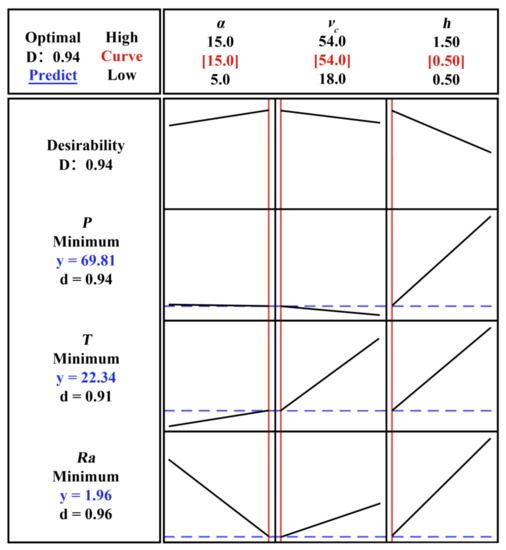
Figure 8.
Optimisation of cutting parameters.
4. Conclusions
For the sake of improving the industrial benefits and product quality of beech machining, changes in cutting power, temperature, and surface roughness at different cutting conditions were explored using the factor analysis method. The following main conclusions were drawn from these experiments:
- (1)
- Changes in cutting power showed a decreasing trend with the decrease in cutting depth and speed, and the increase in rake angle. Cutting depth had the greatest influence on cutting power, followed by rake angle and cutting speed. Furthermore, both the cutting speed and the interactions of rake angle and cutting speed as well as rake angle and depth contributed insignificantly to the cutting power.
- (2)
- Cutting temperature first increased and then decreased with the increase in rake angle, and it increased with the increase in cutting depth and speed. Cutting speed had the greatest contribution to the cutting temperature, followed by cutting depth and rake angle. Only rake angle had an insignificant effect on the cutting temperature. Meanwhile, no interactive impacts on cutting temperature were found.
- (3)
- Surface roughness was positively related to cutting depth but negatively correlated to cutting speed and rake angle. Cutting depth had the greatest effect on the surface roughness, followed by rake angle and cutting speed. Both the rake angle and the cutting speed had insignificant contributions to the surface roughness. No interactive impacts on surface roughness were found.
- (4)
- Cutting parameters were optimised for the multiple targets of lowest cutting power, temperature, and surface roughness. These were determined to be a rake angle of 15°, cutting speed of 54 m/s, and depth of 0.5 mm. This combination of cutting parameters is recommended for applications in industrial beech machining where high enterprise benefits and product quality are desired.
- (5)
- Cutting performance was also affected by the moisture content and cutting direction. Thus, research into the effects of these variables on the cutting performance of beech is suggested for future investigations. Three-dimensional scanning technology and microscopic characterization techniques can be used for further investigation of the beech machined surface.
Author Contributions
Conceptualization, Y.Y., Z.Z., M.S. and D.B.; methodology, H.Y., Z.Z. and D.B.; software, H.Y.; validation, Z.Z., M.S., D.B. and Y.Y.; formal analysis, Y.Y.; investigation, X.D. and Z.Z.; resources, Y.Y., J.W. and Z.Z.; data curation, M.S.; writing—original draft preparation, M.S. and Y.Y.; writing—review and editing, D.B.; visualization, D.B.; supervision, Z.Z.; project administration, Z.Z.; funding acquisition, Z.Z. All authors have read and agreed to the published version of the manuscript.
Funding
This research was supported by the National Natural Science Foundation of China [grant number 31971594], the Natural Science Foundation of the Jiangsu Higher Education Institutions of China [21KJB220009], the Qing Lan Project, and the International Cooperation Joint Laboratory for Production, Education, Research and Application of Ecological Health Care on Home Furnishing.
Data Availability Statement
Not applicable.
Acknowledgments
The authors gratefully acknowledge the considerable support of the CT WOOD at Luleå University of Technology.
Conflicts of Interest
The authors declare no conflict of interest.
References
- Fang, L.; Lu, X.; Mo, X.; Zhang, X.; Gui, C. Performance of impregnated paper decorated blockboard manufactured using HDF as equilibrium layer. Materials 2022, 15, 6342. [Google Scholar] [CrossRef] [PubMed]
- Zhang, X.; Yu, J.; Zhao, J.; Fang, L. Overlaying performance and bonding mechanism of wood-based panels decorated by EVA film reinforced decorative wood veneer. Wood Mater. Sci. Eng. 2022, 1–9. [Google Scholar] [CrossRef]
- Hu, W.; Wan, H.; Guan, H. Size effect on the elastic mechanical properties of beech and its application in finite element analysis of wood structures. Forests 2019, 10, 783. [Google Scholar] [CrossRef]
- Szwajka, K.; Zielińska-Szwajka, J.; Trzepiecinski, T. Experimental study on drilling MDF with tools coated with TiAlN and ZrN. Materials 2019, 12, 386. [Google Scholar] [CrossRef] [PubMed]
- Hakkou, M.; Pétrissans, M.; Gérardin, P.; Zoulalian, A. Investigations of the reasons for fungal durability of heat-treated beech wood. Polym. Degrad. Stab. 2006, 91, 393–397. [Google Scholar] [CrossRef]
- Jin, D.; Wei, K. Machinability of Scots Pine during Peripheral Milling with Helical Cutters. BioResources 2021, 16, 8172. [Google Scholar] [CrossRef]
- Li, R.; Yang, F.; Wang, X. Modeling and Predicting the Machined Surface Roughness and Milling Power in Scot’s Pine Helical Milling Process. Machines 2022, 10, 331. [Google Scholar] [CrossRef]
- Li, R.; He, C.; Xu, W.; Wang, X. Modeling and optimizing the specific cutting energy of medium density fiberboard during the helical up-milling process. Wood Mater. Sci. Eng. 2022, 18, 464–471. [Google Scholar] [CrossRef]
- Zhang, S.; Jiao, F.; Wang, X.; Niu, Y. Modeling of cutting forces in helical milling of unidirectional CFRP considering carbon fiber fracture. J. Manuf. Process. 2021, 68, 1495–1508. [Google Scholar] [CrossRef]
- Davim, J.P.; Clemente, V.; Silva, S. Surface roughness aspects in milling MDF (medium density fibreboard). Int. J. Adv. Manuf. Technol. 2009, 40, 49–55. [Google Scholar] [CrossRef]
- Nasir, V.; Cool, J. A review on wood machining: Characterization, optimization, and monitoring of the sawing process. Wood Mater. Sci. Eng. 2020, 15, 1–16. [Google Scholar] [CrossRef]
- Hlásková, L.; Kopecký, Z.; Novák, V. Influence of wood modification on cutting force, specific cutting resistance and fracture parameters during the sawing process using circular sawing machine. Eur. J. Wood Wood Prod. 2020, 78, 1173–1182. [Google Scholar] [CrossRef]
- Kratky, L.; Jirout, T. Experimental identification and modelling of specific energy requirement for knife milled beech chips in dependence on particle size characteristics and moisture. Energy 2022, 243, 122749. [Google Scholar] [CrossRef]
- Ispas, M.; Gurau, L.; Campean, M.; Hacibektasoglu, M.; Racasan, S. Milling of heat-treated beech wood (Fagus sylvatica L.) and analysis of surface quality. BioResources 2016, 11, 9095–9111. [Google Scholar] [CrossRef]
- Kubš, J.; Kminiak, R. The effect of selected factors on the milled surface quality of thermally modified solid beech. BioResources 2017, 12, 1479–1490. [Google Scholar] [CrossRef]
- Zhu, Z.; Jin, D.; Wu, Z.; Xu, W.; Yu, Y.; Guo, X.; Wang, X. Assessment of surface roughness in milling of beech using a response surface methodology and an adaptive network-based fuzzy inference system. Machines 2022, 10, 567. [Google Scholar] [CrossRef]
- Yilgor, N.; Unsal, O.; Kartal, S.N. Physical, mechanical, and chemical properties of steamed beech wood. For. Prod. J. 2001, 51, 89. [Google Scholar]
- Li, R.; Yao, Q.; Xu, W.; Li, J.; Wang, X. Study of cutting power and power efficiency during straight-tooth cylindrical milling process of particle boards. Materials 2022, 15, 879. [Google Scholar] [CrossRef]
- Dong, W.; Xiong, X.; Ma, Y.; Yue, X. Woodworking tool wear condition monitoring during milling based on power signals and a particle swarm optimization-back propagation neural network. Appl. Sci. 2021, 11, 9026. [Google Scholar] [CrossRef]
- Xiong, X.-Q.; Yuan, Y.-Y.; Niu, Y.-T.; Zhang, L.-T. Research on the effects of roughness on the tactile properties of rice straw particleboard surface. Sci. Adv. Mater. 2020, 12, 795–801. [Google Scholar] [CrossRef]
- Li, R.; He, C.; Chen, Y.; Wang, X. Effects of laser parameters on the width of color change area of poplar wood surface during a single irradiation. Eur. J. Wood Wood Prod. 2021, 79, 1109–1116. [Google Scholar] [CrossRef]
- Wu, Y.; Wu, X.; Yang, F.; Zhang, H.; Feng, X.; Zhang, J. Effect of thermal modification on the nano-mechanical properties of the wood cell wall and waterborne polyacrylic coating. Forests 2020, 11, 1247. [Google Scholar] [CrossRef]
- Li, R.; He, C.; Wang, X. Evaluation and modeling of processability of laser removal technique for bamboo outer layer. JOM 2021, 73, 2423–2430. [Google Scholar] [CrossRef]
- Xiong, X.; Yue, X.; Wu, Z. Current Status and Development Trends of Chinese Intelligent Furniture Industry. J. Renew. Mater. 2023, 11, 1353–1366. [Google Scholar] [CrossRef]
- Morin, A.J.; Myers, N.D.; Lee, S. Modern factor analytic techniques: Bifactor models, exploratory structural equation modeling (ESEM), and bifactor-ESEM. In Handbook of Sport Psychology; John Wiley & Sons, Inc.: Hoboken, NJ, USA, 2020; pp. 1044–1073. [Google Scholar] [CrossRef]
- Su, Y.; Li, C.; Zhao, G.; Li, C.; Zhao, G. Prediction models for specific energy consumption of machine tools and surface roughness based on cutting parameters and tool wear. Proc. Inst. Mech. Eng. Part B J. Eng. Manuf. 2021, 235, 1225–1234. [Google Scholar] [CrossRef]
- Xu, W.; Wu, Z.; Lu, W.; Yu, Y.; Wang, J.; Zhu, Z.; Wang, X. Investigation on cutting power of wood–plastic composite using response surface methodology. Forests 2022, 13, 1397. [Google Scholar] [CrossRef]
- Nasir, V.; Kooshkbaghi, M.; Cool, J.; Sassani, F. Cutting tool temperature monitoring in circular sawing: Measurement and multi-sensor feature fusion-based prediction. Int. J. Adv. Manuf. Technol. 2021, 112, 2413–2424. [Google Scholar] [CrossRef]
- Song, M.; Buck, D.; Yu, Y.; Du, X.; Guo, X.; Wang, J.; Zhu, Z. Effects of Tool Tooth Number and Cutting Parameters on Milling Performance for Bamboo–Plastic Composite. Forests 2023, 14, 433. [Google Scholar] [CrossRef]
- Cui, Z.; Ni, J.; He, L.; Guan, L.; Han, L.; Sun, J. Investigation of chip formation, cutting force and surface roughness during orthogonal cutting of polytetrafluoroethylene. J. Manuf. Process. 2022, 77, 485–494. [Google Scholar] [CrossRef]
- Cao, Q.; Tang, Q.; Jun, J.; Cui, Z.; Zhu, Z. Research on the helical milling performance of beech wood. J. For. Eng. 2023, 8, 68–74. [Google Scholar]
- Magoss, E. Evaluating of the surface roughness of sanded wood. Wood Res. 2015, 60, 783–790. [Google Scholar]
- Feng, X.; Chen, J.; Yu, S.; Wu, Z.; Huang, Q. Mild hydrothermal modification of beech wood (Zelkova schneideriana Hand-Mzt): Its physical, structural, and mechanical properties. Eur. J. Wood Wood Prod. 2022, 80, 933–945. [Google Scholar] [CrossRef]
- Hu, J.; Liu, Y.; Xu, W.; Wu, Z.; Pang, X. Effects of Preparation and Self-Assembly of Poly (Styrene-Acrylic Acid)(P (St-AA)) Microspheres Upon Constructed Photonic Crystals with Structural Color on Wood Surfaces. Coatings 2022, 12, 1520. [Google Scholar] [CrossRef]
- Wu, Z.; Wang, J.; Zhang, F.; Zhu, Z.; Guo, X.; Cao, P. Investigation of the orthogonal cutting of wood-plastic composites for obtaining better stability and quality. Eur. J. Wood Wood Prod. 2023, 81, 399–410. [Google Scholar] [CrossRef]
- Nasir, V.; Cool, J. Optimal power consumption and surface quality in the circular sawing process of Douglas-fir wood. Eur. J. Wood Wood Prod. 2019, 77, 609–617. [Google Scholar] [CrossRef]
Disclaimer/Publisher’s Note: The statements, opinions and data contained in all publications are solely those of the individual author(s) and contributor(s) and not of MDPI and/or the editor(s). MDPI and/or the editor(s) disclaim responsibility for any injury to people or property resulting from any ideas, methods, instructions or products referred to in the content. |
© 2023 by the authors. Licensee MDPI, Basel, Switzerland. This article is an open access article distributed under the terms and conditions of the Creative Commons Attribution (CC BY) license (https://creativecommons.org/licenses/by/4.0/).